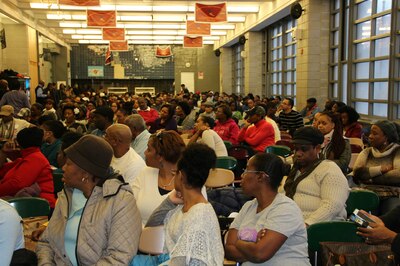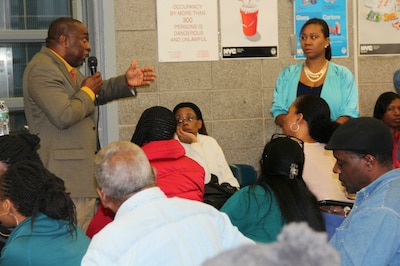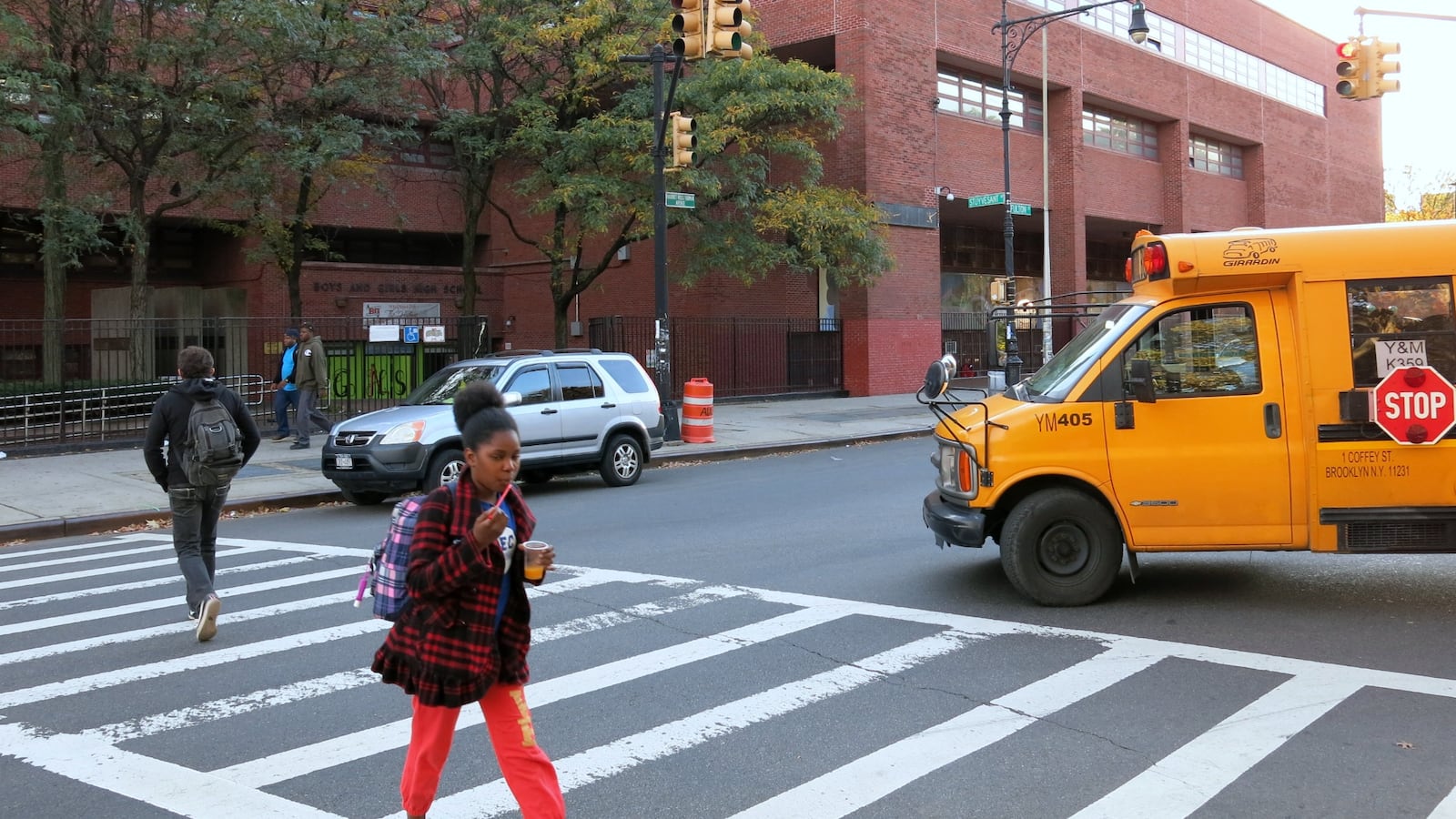At a town hall meeting Saturday in the packed cafeteria of Medgar Evers College Preparatory School, longtime principal Michael Wiltshire made a bold proposal.
He suggested moving the selective school with a 96 percent graduation rate from its crowded Crown Heights building into one occupied by Boys and Girls High School — one of the city’s most troubled schools, with a dwindling enrollment and a 50 percent graduation rate.
If anyone can engineer the move, it is Wiltshire, who was recruited to also lead Boys and Girls by Chancellor Carmen Fariña last year in a last-ditch effort to spare the historic Bedford-Stuyvesant school from state takeover or closure. His plan is highly unusual: There are few examples of a principal of two schools moving one into the other.
The relocation, which the city education department says it is considering, would not combine the schools, as Wiltshire proposed earlier this year. But it would provide a high-stakes test of Fariña’s theory that one way to transform a struggling school is to pair it with a high-performing neighbor.
It would also fulfill a basic need for Medgar Evers, which Wiltshire has called attention to for years: better facilities.
At the meeting, Wiltshire explained that the school, which serves grades six through 12, must squeeze nearly 1,300 students into a building with fewer than 30 classrooms and no gym or auditorium. Meanwhile, Boys and Girls and two other small schools serve about 870 students inside a building that can hold more than 3,200. That building has an immense auditorium, a $400,000 football field, and programs to teach welding, architecture, and computer science.
“I see this as an opportunity to get the facilities that our kids deserve,” Wiltshire told the crowd, according to an audio recording of the meeting. He added, “If we don’t move to that facility, someone else is going to take it.”

The meeting was just the latest twist in the unusual relationship of the odd-couple schools — a pairing that hinges on Michael Wiltshire.
Last year, the city gave Wiltshire, who had transformed Medgar Evers from a mediocre school into a Brooklyn powerhouse, a hefty bonus to attempt the same at Boys and Girls. He soon arranged for some cross-school exchanges of students and staff. Then, this spring, Chalkbeat reported that he had proposed a full merger of the two schools inside Boys and Girls’ sprawling campus.
That consolidation plan has since been replaced by the co-location proposal. The idea is that Medgar Evers would benefit from the extra space and facilities, while Boys and Girls would profit from the proximity to a high-achieving school: Their teachers could collaborate, students could take more advanced classes, and applicants who don’t make it into Medgar Evers might consider enrolling at Boys and Girls.
That prospect has been alluring enough to sway some Boys and Girls supporters who opposed past co-location plans.
“We think this would be a win-win,” said Albert Vann, a former city councilman who is on Boys and Girls’ high-powered advisory board. “We’re hoping to get this done as soon as possible.”
But not everyone is on board.

Saturday’s meeting grew contentious as several parents said they would fear for their children’s safety in an unfamiliar neighborhood and school that, unlike theirs, has metal detectors. Others worried about the fate of the school’s close partnership with neighboring Medgar Evers College. And some felt shut out of the planning process.
“Most of the parents were not for the move,” said Laura Phillips, the mother of an eighth-grade student at Medgar Evers, who left the meeting convinced that the relocation is a done deal. “It sounds to me like they got the space and they’re trying to ease parents into it.”
Meanwhile, staffers at the two other schools in the Boys and Girls campus said they had not been told about the proposal.
“No one has approached me,” said Tabari Zaid Bomani, principal of Nelson Mandela School for Social Justice, a high school that opened in the building last year. It currently serves about 215 students in grades nine and 10, and could enroll twice as many as it grows to full size.
“Where would you put all those students and staff? How would you service four schools in one cafeteria?” he asked, though he also vowed to help any new co-location succeed.
Wiltshire’s two schools face very different dilemmas, which the relocation could help resolve.
Boys and Girls, which does not screen applicants, has watched its reputation wither as its graduation rate sank far below the city average and it earned successive “F” ratings, causing students to shun the school. (Its enrollment plummeted from 2,300 to 385 over the past five years.) Today, it is one of a handful of city schools the state has designated as “out of time” to make drastic changes or face closure.
Since Wiltshire’s appointment as Boys and Girls’ “ambassador principal,” its students have taken foreign language and Advanced Placement courses at Medgar Evers and teachers from the two schools have participated in joint trainings. Wiltshire intends to ramp up that collaboration through a $1.25 million state grant that Boys and Girls won this year, which is meant to spur socio-economic integration at the school. A shared building could potentially strengthen that partnership.
“That building can be the Stuyvesant for our kids,” Wiltshire said Saturday, referring to the elite Manhattan high school.
Meanwhile, Medgar Evers, which admits students based on their test scores and other factors, has enjoyed rising enrollment and graduation rates. Last year, about half of the school’s 219 graduates had taken a semester or two at adjacent Medgar Evers College, and 50 graduated with associates degrees.
But the school’s success has led to overcrowding, forcing it to turn away some eligible applicants. Wiltshire has said that if the school had more space it could easily double its enrollment.
In an interview this week, he said that while the city spends millions of dollars on struggling schools like Boys and Girls, it often overlooks higher-performers such as Medgar Evers.
“Here you have a school that is doing well and you ignore it,” he said, arguing that the school has long outgrown its current space. “We’re crying out for help.”
Education department spokeswoman Devora Kaye said officials would meet with parents and staffers at the affected schools and hold public forums to discuss the proposal. If the city decides to move forward with it, a public notice would be posted by March, followed by a vote by the city’s education policy board.
Still, many at Medgar Evers suspect that a move is already in the works, whether they want it or not.
“Is there really a choice?” said 11th-grader Ahkel Bailey. If the city approves the move, “I don’t care what anybody says, we’re going.”

